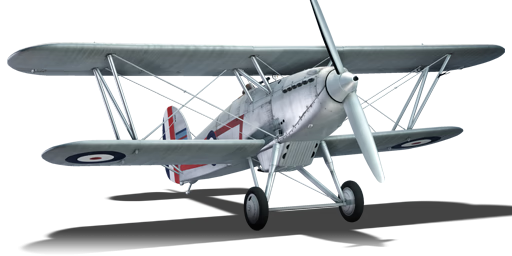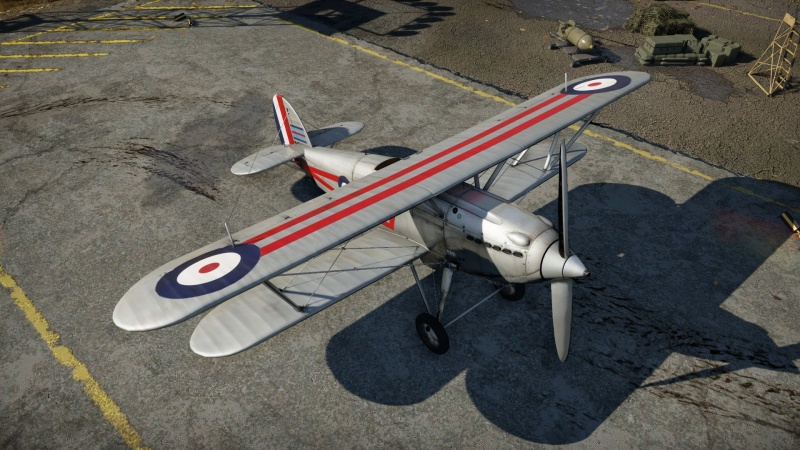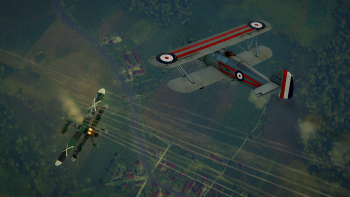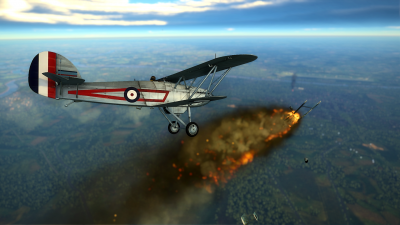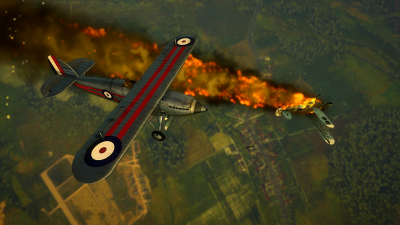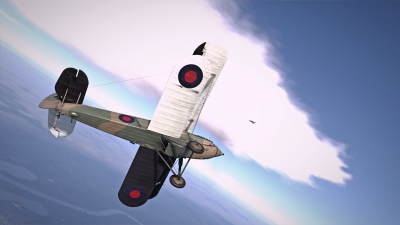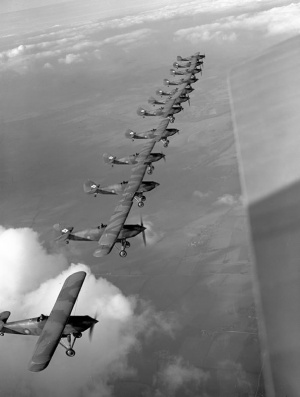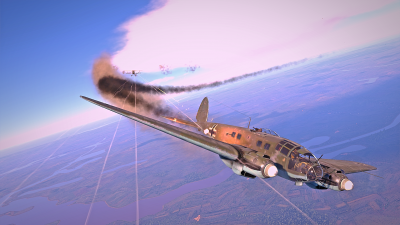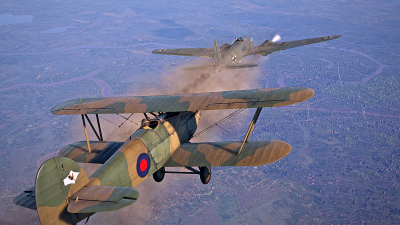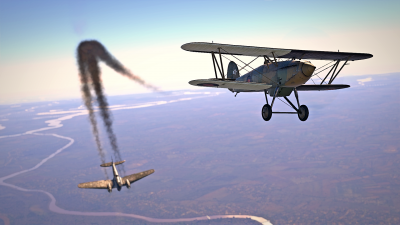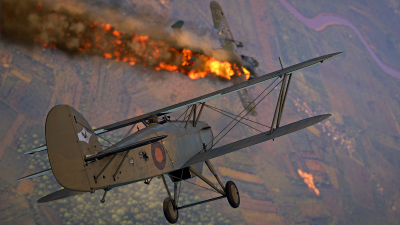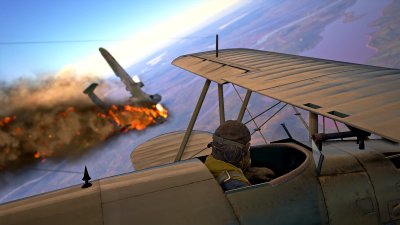Difference between revisions of "Fury Mk I"
(If you don't like something, it's better to write about it. I made the History shorter and clearer. If you do not like something else, write me, but do not delete my work.) (Tag: Visual edit) |
Colok76286 (talk | contribs) (Undo revision 130780 by U122981054 (talk)) |
||
| Line 175: | Line 175: | ||
[[File:Formation Fury Mk.1.jpg|thumb|Formation {{PAGENAME}}]] | [[File:Formation Fury Mk.1.jpg|thumb|Formation {{PAGENAME}}]] | ||
| − | The first prototype (Hornet) was presented in 1927. For the first time, a biplane completely ready for production took off in March 1931 and entered service with the RAF in May of the same year. This plane was designed by H.G. Hawker Engineering Co. Ltd (Hawker Aircraft Ltd since 1933) under the direction of Sidney Camm | + | The first prototype (Hornet) was presented in 1927. For the first time, a biplane completely ready for production took off in March 1931 and entered service with the RAF in May of the same year. This plane was designed by H.G. Hawker Engineering Co. Ltd (Hawker Aircraft Ltd since 1933) under the direction of Sidney Camm |
In August 1930 H.G. Hawker Engineering Co. Ltd has entered into a contract for serial production of the first twenty Hornet fighters. At this time, the F. 13/30 specification was released, according to which ground-based aircraft received the name with the F index, and carrier-based aircraft - N. The Hornet fighter was named Fury (from the word fury) and added Mk I, to indicate modification.The Fury was designed by H.G. Hawker Engineering Co. Ltd (Hawker Aircraft Ltd since 1933) under the direction of Sidney Camm. | In August 1930 H.G. Hawker Engineering Co. Ltd has entered into a contract for serial production of the first twenty Hornet fighters. At this time, the F. 13/30 specification was released, according to which ground-based aircraft received the name with the F index, and carrier-based aircraft - N. The Hornet fighter was named Fury (from the word fury) and added Mk I, to indicate modification.The Fury was designed by H.G. Hawker Engineering Co. Ltd (Hawker Aircraft Ltd since 1933) under the direction of Sidney Camm. | ||
Revision as of 12:20, 15 June 2022
| This page is about the British fighter Fury Mk I. For the other version, see Fury Mk II. For other uses, see Fury (Disambiguation). |
Contents
Description
he is a reserve rank I British fighter with a battle rating of 1.0 (AB/RB/SB). All-metal single-seat biplane with an open cockpit and fixed landing gear. It has been in the game since the start of the Open Beta Test prior to Update 1.27.
The Fury Mk I is one of the three reserve fighters in the British tree - the other two being the Nimrod Mk I (a naval version Fury), as well as the Fury Mk II. As a reserve plane, the Fury isn't a manoeuvrable or fast plane. Its armament, two 7.7 mm machine guns Which is one of the worst weapons among reserve aircaft.
The Furies in all their variants also turn decently, though they do tend to bleed energy easily and aren't the best planes in climbing or acceleration. The modelled fixed pitch prop will mean not much power is around for climbing at the start of the match - a problem also currently shared with the later Gladiators.The first prototype was presented in 1927. For the first time, a biplane completely ready for production took off in March 1931 and entered service with the RAF in May of the same year. Also was in service with Yugoslavia, Iran, South Africa (Union of South Africa). He participated in the Spanish Civil War, as well as in the Second World War, but in most cases was used for public performances. Fury Mk I did not become a mass RAF (Royal Air Force) fighter, however, Fury pilots were considered an elite. A total of 117 Fury Mk I modification fighters were produced in five series. In 1937 the Fury Mk II was introduced with a more powerful engine. It replaced the Fury Mk I in production and on airfields.
General info
Flight performance
| Characteristics | Max Speed (km/h at 4,100 m) |
Max altitude (metres) |
Turn time (seconds) |
Rate of climb (metres/second) |
Take-off run (metres) | |||
|---|---|---|---|---|---|---|---|---|
| AB | RB | AB | RB | AB | RB | |||
| Stock | 385 | 371 | 8100 | 16.2 | 16.9 | 13.7 | 13.7 | 232 |
| Upgraded | 403 | 394 | 15.8 | 16.0 | 19.2 | 15.7 | ||
Details
| Features | ||||
|---|---|---|---|---|
| Combat flaps | Take-off flaps | Landing flaps | Air brakes | Arrestor gear |
| X | X | X | X | X |
| Limits | ||||||
|---|---|---|---|---|---|---|
| Wings (km/h) | Gear (km/h) | Flaps (km/h) | Max Static G | |||
| Combat | Take-off | Landing | + | - | ||
| 600 | 600 | N/A | N/A | N/A | ~11 | ~5 |
| Optimal velocities (km/h) | |||
|---|---|---|---|
| Ailerons | Rudder | Elevators | Radiator |
| < 260 | < 200 | < 300 | > 200 |
| Compressor (RB/SB) | ||
|---|---|---|
| Setting 1 | ||
| Optimal altitude | 100% Engine power | WEP Engine power |
| 3,705 m | 600 hp | N/A |
Survivability and armour
The Fury Mk I was an aircraft that was stripped of all which was unnecessary to enable it to be the lightest and fastest possible. Like many biplanes just before the start of World War II, the only protection afforded the pilot was the wood and canvas around him and the engine at the front of the aircraft. The best course of protection for this aircraft is to gain the element of surprise as it will not take much to damage critical components or knock out the pilot. All critical modules are concentrated in the forward fuselage area so attacks from the front or the side tend to do the most damage quickly.
- No armour protection
- Largely wood and canvas construction
- Self-sealing fuel tanks
Modifications and economy
Armaments
Offensive armament
The rate of fire of these guns is average among rate 1.0. But the ammunition for one gun is one of the best in this battle rating. It is aloud to fire 80 seconds. For this rate it is grate.
Use Universal or Stealth rounds with the Vickers K guns but keep in mind that unlike the current modelled Brownings as used on Gladiators, Hurricanes and Spitfires, these 7.7 mm guns won't do much damage unless you aim for the most vulnerabl
Usage in battles
If you want to use the Fury, the best advice is to side climb a bit at the start of the match so you at least have some energy to work with. Plan manoeuvres ahead and go for easy targets such as inattentive planes and attackers destroying ground vehicles. Most of the problems with the plane are mitigated in Arcade Battles as traits like engine overheating and wing rip-offs are not modelled in that mode.
The Fury Mk I is a typical reserve aircraft in that it is an unremarkable plane. It is neither outstanding in speed, its manoeuvrability or even weapons loadout. Though contemporary aircraft may have a speed advantage, beefier weapons or even more manoeuvrability, the Fury Mk I can still find its place on the battlefield in both in air battles and the ground attack game.
- Ground Attack
The Fury Mk I has a crazy low stall-speed which allows it to circle anti-aircraft artillery or anti-aircraft vehicles easily. Though the plane's Vickers 7.7 mm machine guns are relatively weak, they can wreak havoc on the ground targets if enough bullets connect with their targets. If there are no enemy aircraft circling above the Mk I, then it can leisurely eliminate the ground targets, even tightly grouped vehicles. Even without access to bombs, the Fury Mk I can be an effective ground attacker.
- Air-to-air Attack
With many contemporary aircraft using faster firing machine guns, larger calibre guns or just more of them, it will take a skilful Fury pilot to balance or tip the scales. With 600 rounds of ammunition for each Vickers machine gun, there is a lot to work with; however, it is to the pilot's detriment to spray bullets everywhere. To make the most impact with the 7.7 mm rounds, the best chances to hit the enemy are when while in close. The longer the shot, the more likely bullets will either miss or harmlessly bounce off the target. Attacking close in between 100 and 300 m gives the best chances in critically damaging the enemy. Unless the pilot pulls off a pilot snipe and knocks out the pilot, chances are it may take a couple passes to inflict enough damage to send the target to the ground in flames. Close in attacks may offer the best opportunities to damage the enemy, but it can make for some hectic flying.
The 7.7 mm bullets fired at aircraft fuselage do relatively little damage; therefore, it is crucial to target critical components such as the pilot, engines, oil coolers, and fuel tanks to eliminate the enemy effectively. Aircraft wings can also be susceptible to snapping if enough bullets perforate the skin and structure.
One use for the Fury Mk I is as an early interceptor aircraft against bombers. While Do-17, TBD-1, SB 2M, Ki-21, and F.222.2 bombers have various defensive gunners, they are not impossible to shoot down with the Fury. The pilot does need to watch how they approach the bombers. Typically flying in from the front or the underside of the bombers allows for an unscathed approach. However, if you find that you must approach with a defensive position firing at you, make small adjustments to stay out of the line of fire and wait for the gunner to run out of ammunition before levelling off and taking a shot. Chances are you can knock out the gunner or even work on taking out the engines. A crippled bomber easily allows the more manoeuvrable biplane to make enough passes to finish the job.
Manual Engine Control
| MEC elements | ||||||
|---|---|---|---|---|---|---|
| Mixer | Pitch | Radiator | Supercharger | Turbocharger | ||
| Oil | Water | Type | ||||
| Controllable | Not controllable Not auto controlled |
Not controllable Not auto controlled |
Controllable Not auto controlled |
Combined | Not controllable 1 gear |
Not controllable |
Pros and cons
Pros:
- Turns well for a biplane
- Excellent vertical manoeuvrability
- Incredibly low stall speed
- Engine never overheats, only on the really hot maps
Cons:
- Only has two rifle-calibre 7.7 mm machine guns, a challenge to damage enemy aircraft
- Loses energy quite easily, mostly able to turn just once or twice
- Not very beginner-friendly due to its flying characteristics
- There is not WEP
History
The first prototype (Hornet) was presented in 1927. For the first time, a biplane completely ready for production took off in March 1931 and entered service with the RAF in May of the same year. This plane was designed by H.G. Hawker Engineering Co. Ltd (Hawker Aircraft Ltd since 1933) under the direction of Sidney Camm
In August 1930 H.G. Hawker Engineering Co. Ltd has entered into a contract for serial production of the first twenty Hornet fighters. At this time, the F. 13/30 specification was released, according to which ground-based aircraft received the name with the F index, and carrier-based aircraft - N. The Hornet fighter was named Fury (from the word fury) and added Mk I, to indicate modification.The Fury was designed by H.G. Hawker Engineering Co. Ltd (Hawker Aircraft Ltd since 1933) under the direction of Sidney Camm.
An elegant aircraft with streamlined fuselage contours, the Fury Mk I was the first RAF fighter with a speed exceeding 322 km/h (200 mph).
Most aircraft were equipped with a 525 hp liquid-cooled in-line twelve-cylinder Rolls-Royce Kestrel IIS engine and a wooden twin-bladed Watts propeller, although several alternative powerplants became available during the Fury's service life.
The introduction of the aircraft into the Royal Air Force was not massive. The Fury was an expensive aircraft and, with Britain being in the grip of a financial depression, initially only enough aircraft were ordered to equip three squadrons; Nos 1, 25 and 43 Squadrons.
The armament consisted of two synchronous Vickers Mk.IV, mounted in front of the cockpit. Whilst the Fury was an excellent fighter when it first entered service, it did mark the end of an era as one of the last open cockpit, biplane fighters produced by Britain. Its fixed undercarriage, fabric skin and twin Vickers guns were reminiscent of fighters of the First World War, and when it was replaced in front line service with the RAF in 1939, it truly was a relic of a bygone era.
A total of 117 Fury Mk I fighters were produced, in five series.
The Fury Mk II was built by installing a more powerful 640 hp Kestrel VI engine, which allowed for a significant increase in flight performance. Olso installed fairings on the chassis. In all other aspects, this is still the same Fury Mk I.
Equipment and design features
The Fury's fuselage, wings, and tail had a metal framework and a fabric skin. The skin of the forward fuselage up to the cockpit and the engine cowling was made of duralumin sheets. Ailerons were fitted to the upper wing; nevertheless, due to their large area, they were very responsive and provided the aircraft with a high roll rate.The instrumentation consisted of the bare necessities, indicators of: speed, roll, slip, engine speed, fuel pressure, oil temperature, fuel consumption and a water temperature gauge in the cooling system. Radio stations were installed on some fighters. The design of the Fury is the same as that of its deck relative, the Nimrod Mk.1. Only the Nimrod has a larger wingspan and an extra radiator under the engine.
Media
- Skins
- Images
- Videos
See also
- Fury Modifications for Export (History)
- The history of the restoration of the last Fury in the world (History)
- Nimrod Mk I - is a deck cousin of the Fury
- Fury Mk II - Upgrade of Fury Mk I
External links
| Hawker Aircraft Limited | |
|---|---|
| Biplane fighters | |
| Fury | Fury Mk I · Fury Mk II |
| Nimrod | Nimrod Mk I · Nimrod Mk II |
| Scout plane | Osprey Mk IV |
| Piston fighters | |
| Hurricane | Hurricane Mk I/L · Hurricane Mk.I/L FAA M · Sea Hurricane Mk IB · Sea Hurricane Mk IC · Hurricane Mk IIB/Trop · Hurricane Mk IV |
| Typhoon | Typhoon Mk Ia · Typhoon Mk Ib · Typhoon Mk Ib/L |
| Tempest | Tempest Mk V · Tempest Mk V (Vickers P) · Tempest Mk II |
| Fury | Sea Fury FB 11 |
| Jet fighters | |
| Hunter | Hunter F.1 · Hunter F.6 · Hunter FGA.9 |
| Sea Hawk | Sea Hawk FGA.6 |
| Harrier | Harrier GR.1 · Harrier GR.3 |
| Export | ▄Hurricane Mk I/L · ▂Hurricane Mk IIB · ◘Sea Fury FB 51 |
| ◘Sea Hawk Mk.50 · ◄Sea Hawk Mk.100 · ◘Hunter F.6 · ◌Hunter F.58 · J34 · AV-8A · AV-8C · ▄AV-8S | |
| Captured | ▀Tempest Mk V |
| See Also | Fokker |


